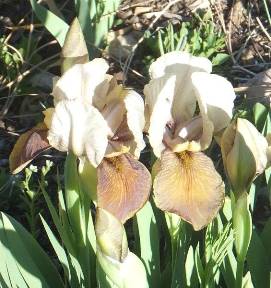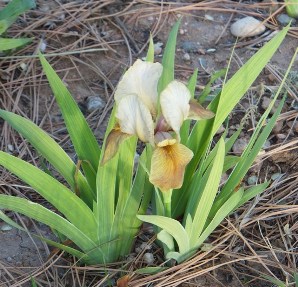|

|
Zwanenburg
|
 The culrivar 'Zwanenburg' was introduced by Louis Denis is 1912. Its
parentage is given as 'Lutescens Aurea' x I. susiana.
'Lutescens Aurea' is a dwarf bearded cultivar of the I.
lutescens group. 'Zwanenburg' has some fertility as a pollen
parent, having produced seven registered offspring.
The culrivar 'Zwanenburg' was introduced by Louis Denis is 1912. Its
parentage is given as 'Lutescens Aurea' x I. susiana.
'Lutescens Aurea' is a dwarf bearded cultivar of the I.
lutescens group. 'Zwanenburg' has some fertility as a pollen
parent, having produced seven registered offspring.
In 1955 (in translation, ASI Yearbook
1966), Marc Simonet reported a chromosome count of 42, and
suggested that the stated parentage was in error, and that the pollen
parent was 'Ib-Mac', which Denis grew and used extensively. This
would make it an unbalanced tetraploid of the APTT type.
Simonet also cited the general resemblance of 'Zwanenburg' to other
arilbreds from I. lutescens x 'Ib-Mac'. I would have to concur
with the observation. On an established clump, 'Zwanenburg' produces
stalks with two terminal buds plus a full branch (sometimes reduced
to a spur). This seems unlikely if the single-flowered I.
susiana were the parent, as lutescens-type dwarfs have
just one or two terminal buds.
In the 1978 ASI Yearbook, however,
Randolph and Mitra reported counting 'Zwanenburg' as 2n=40. Their
interpretation was that the published parentage is correct, and that
I. susiana contributed an unreduced gamete, making
'Zwanenburg' AAPT. Interestingly, Sidney Mitchell stated that
he believed the correct parentage is I. susiana X 'Statellae'
(also a dwarf of the I. lutescens type). This adds
plausibility to the unreduced gamete interpretation. Note that the
remark "counted as an amphidiploid", which has appeared in several
earlier ASI checklists, is not correct in either case, because the
two sets of bearded chromosomes from I. lutescens are
different from each other (PT).
Who is correct? I initially tended to follow
Randolph and Mitra. With their being aware of Simonet's count, we can
assume they would take extra care to ensure that their contradictory
result was correct. Their interpretation also has the advantage of
being consistent with the published parentage (and Mitchell's
suggested correction). On the other hand, Simonet's suggestion cannot
be ruled out. 'Zwanenburg' produces rather tall stems, often bearing
a branch. Although this is not impossible for a hybrid coming solely
from I. lutescens and I. susiana, it seems very
unlikely. The stem is much more like what one would expect from
Simonet's suggested parentage.
The two chromosome configurations should
result in different breeding behaviors. While either would be
expected to produce AT gametes about half the time, if Simonet
is correct the other half should be PT, whereas if Randolph
and Mitra are correct, the other half should be AP. If Simonet
is correct, crossing 'Zwanenburg' with SDBs should produce some
fertile SDB seedlings. If Randolph and Mitra are correct, crossing
'Zwanenburg' with arilpums should produce some fertile arilpum
seedlings. Alas, the latter hypothesis cannot be readily tested,
since the only arilpums presently available, 'Barbarella' and
'Aladdin's Gem' are, like 'Zwanenburg', only fertile as pollen
parent. (Werckmeister did report once getting a pod with two viable
seeds from 'Zwanenburg' during an especially warm and dry
season.)
Of the registered offspring of 'Zwanenburg',
five were produced by using its pollen on SDBs, and two from TBs. One
of the SDB x 'Zwanenburg' seedlings, 'Brownie', was registered as an
MDB, is fertile both ways, and was subsequently used to produce other
MDBs, SDBs and IBs. Although not conclusive, this suggests that
Simonet may have been correct. For confirmation, one would need to
produce a substantial number of SDB x 'Zwanenburg' seedlings and test
them for fertility.
Tom
Waters
September 2011
updated November
2017
Unless otherwise noted, all text
and illustrations copyright Tom Waters and all photographs copyright
Tom or Karen Waters. Please do not reproduce without
permission.
 The culrivar 'Zwanenburg' was introduced by Louis Denis is 1912. Its
parentage is given as 'Lutescens Aurea' x I. susiana.
'Lutescens Aurea' is a dwarf bearded cultivar of the I.
lutescens group. 'Zwanenburg' has some fertility as a pollen
parent, having produced seven registered offspring.
The culrivar 'Zwanenburg' was introduced by Louis Denis is 1912. Its
parentage is given as 'Lutescens Aurea' x I. susiana.
'Lutescens Aurea' is a dwarf bearded cultivar of the I.
lutescens group. 'Zwanenburg' has some fertility as a pollen
parent, having produced seven registered offspring.
